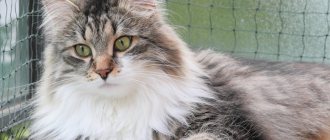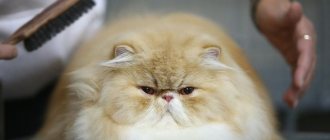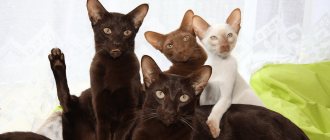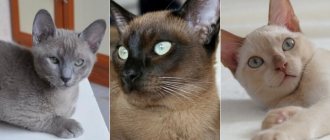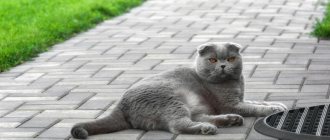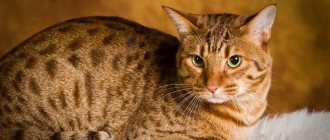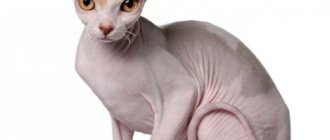The Italians included themselves among the creators of only one cat breed - Ceylon cat. There were no natives on the Apennine Peninsula, so a couple of cats were brought from afar (from Sri Lanka) and given them the opportunity to breed. There is nothing special about Ceylon cats that one could focus on. They wrote that they are very similar to wild jungle cats (Felis сhaus), and also, they say, the inhabitants of Sri Lanka see the head of a sacred cobra in the pattern on their forehead. In all these dashes and stripes we see the letter “M”, or a crown, or a scarab beetle.
Short story
The Ceylon cat breed is the “creation” of the Italian Paolo Pellegatta, a veterinarian and felinologist, who, while traveling around Sri Lanka (the former name of the island of Ceylon), in 1984, could not resist the charm of the miniature cats living in Buddhist temples. Removing the two animals was not an easy task, and if not for the help of the director of the zoo in the capital, Colombo, who signed the necessary documents, the Italian might have returned home empty-handed. However, everything turned out well, and after returning, Pellegatta showed Tissa and Taranya to his colleagues. The cats had a hard time with climate change and were in a room with a constant temperature of about plus 30°C, dressed in warm blouses. They were small and light in weight, with very short hair and modest food requirements, which were considered good traits for domestic cats. A few days later, a club for Ceylon cat lovers was organized in Italy. The cats quickly took root in the new conditions. The best Italian breeders worked on the breed, and their hard work was appreciated all over the world. A few years later, the Ceylon cat triumphantly paraded through numerous national and international exhibitions. In 1989, the breed received recognition from experts of the FIAF system (Italy), and in October 1993 - WCF.
Why do Russian cat lovers ignore such a pleasant breed in all respects? Perhaps it is difficult to import cats from Italy, or perhaps Italian breeders do not want to send kittens to the harsh Russian climate.
Appearance: description of Ceylon
Ceylon cats are distinguished by their neat appearance and very small size. Adult representatives reach a maximum weight of 2.5 to 4 kg, beyond which there are rare exceptions.
Detailed description of appearance:
- The head is wide, round in shape, on a short neck. Well-defined cheekbones, a slightly flat forehead, with a slight curve visible in profile. The lower jaw and chin are expressive.
- The ears are large, especially wide at the base, set high and close to each other. Rounded tips.
- The eyes are voluminous, wide-set. The upper part of the eyes is almond-shaped, the lower part is round. Eye colors range from green to bright yellow.
- The nose is small and short.
- The body is small and medium in size, miniature. The chest is very developed. The hips and shoulders are quite wide, the belly is rounded.
- The paws are medium in size, slender and rounded at the pads.
- The tail is small in size, tapering towards the tip.
- The coat is thin, short, with a silky texture. A small undercoat is visible.
Varieties of color
Most often, Ceylon cats are found with a monochromatic coat color accompanied by ticking, which is very reminiscent of the Abyssinian breed. The main tonality of the color belongs to the range of colors from sand to golden. Ticking colors come in the following shades:
- black;
- red;
- tortoiseshell;
- cream;
- bluish-cream.
In the neck area, the stripes may be intermittent, as opposed to the clear stripes running along the back, paws and tail. Each Ceylon cat has a pattern on its forehead in the image of a snake's head or the letter "M". The belly is decorated with a spotted pattern running in double rows, and the tip of the tail is ticked in color. The pads are colored in the same tone as the main color, the nose of the cats is pink with a thin border around it to match the color of the fur. You can take a closer look at the Ceylon cat in the photo, where the color pattern is easily visible.
About the character of the Ceylon breed
Ceylon cats are known for being friendly and trusting. They become very attached to their owner, who becomes for them the main creature in the entire universe. The breed is distinguished by patience and obedience. Great lovers of active games, these animals are always careful not to upset their beloved owner with spilled soil from a flower pot or a torn curtain.
Representatives of Ceylon love communication with people and constantly need it, but they will never become intrusive if the owner cannot devote time to them. Rather, they will obediently wait until the owner is free and plays with the pet. Ceylon cats are known for their friendliness towards other pets. There is no aggression or jealousy in them, and therefore even a dog will be revered as the best friend in the family.
Character and behavior
Ceylon cats are sociable and friendly, balanced and calm, peaceful and trusting, easy to win over, love communication, and perfectly sense the mood of their owner. They love to jump on their owner's shoulders, sit there, purring loudly, and even take a nap. But since cats are miniature, this cute habit is unlikely to burden the owner.
The Ceylon cat is “talkative”; the intonations of its voice have many vowels with a lot of different shades. Pets of this breed always greet those who enter the house, running out with a raised tail and a friendly meow. They are curious: they like to look into a shopping bag, into an open desk drawer, into a closet, etc. They get along easily with other cats and dogs.
Historical information
From the name of these cats it is clear that they come from the island of Ceylon, which is now called Sri Lanka.
In 1984, the doctor Paolo Pelegatta arrived there from Italy. Tom really fell in love with the cats living there, and he took several to his homeland. There, with the help of felinologists, he launched the selection process in order to create a breed, removing unnecessary properties, and determine the standard. It is difficult to definitively establish the origin of the Ceylonese, since other felines, fiery ones, and those with spots also lived on that island. They could have participated in the birth of the current breed. Perhaps forest cats took part in the natural formation. Ceylon beauties are somewhat similar to Thai ones.
Care and maintenance
Maintenance is easy. You will need a comb with fine metal teeth and a soft rubber brush. Ceylon cats themselves carefully monitor their hygiene, lick their fur and wash themselves, which, by the way, naturally stimulates blood circulation and increases muscle tone. Sometimes you can use a special lotion that enhances the shine of the coat. Like any other cat, they need to have their nails trimmed, ears and teeth cleaned. Get a “cat tree” or other structure with a scratching post, rest areas, houses, a hammock, etc. Their diet should consist of super-premium food and should be given strictly according to the norm.
Colors
The color of these cats is very similar to the Abyssinian breed, for the most part they are found in a single color, sometimes there is a slight ticking. There are several types of ticking, the continental one is considered the most valuable, since the body has unevenly scattered colored hairs. There are several common types of colors in Ceylon cats: black, red, tortoiseshell, cream, blue-cream.
There are also rare cat colors from blue to brown. They usually have a stripe pattern on their back, tail and legs. Each such cat has a certain pattern on its forehead, either in the form of a snake’s head or the letter “M”.
We suggest you read: What to feed a cat with kidney failure, choosing the right diet
Buying a kitten
The Ceylon cat is a rare breed. It can be purchased in Italy. Decide for what purpose you are buying the animal. For breeding or as a companion? Analyze the sites, meet the breeders in absentia, look at the posted photos, print and study the standard. In any case, you should not purchase a kitten younger than 3–4 months. At the nursery, do not rush to pick up your baby. Examine not only the kittens, but also the cat (getting to know the parents and their pedigrees is necessary). Be sure to hold the baby in your arms, and although the breed is a “small” one, the kitten should not look tiny, much less skinny with protruding ribs and spine. A healthy baby is active, playful, inquisitive and has a clean, shiny coat. Make sure that vaccinations and deworming were done at the veterinary clinic and the dates are entered in the veterinary passport, ask about the baby’s habits, play with him. A reputable breeder will not sell such a rare cat without a contract, which will stipulate, for example, mandatory castration/sterilization or participation in exhibitions in an advertising class. If the purchase is made abroad, translate all clauses of the contract and make sure that they do not violate your status as a buyer.
How to properly care for the breed
Ceylon cats are easy to care for and delight owners with their unpretentiousness, and for a happy pet’s life it is enough to follow only a few important points.
- Since the breed has short fur, it requires brushing no more than 1-2 times a week.
- Cats do not like water procedures, which cause fear and panic in them, so you should not bathe the animal unless absolutely necessary.
- Cats need to have their eyes and ears cleaned weekly. For this procedure, you can use a paper napkin or a damp cotton pad.
- Pets from Ceylon living in apartments do not welcome street walks, preferring comfortable home conditions.
Health of Ceylon cats
Cats have a strong immune system and rarely get sick, but try not to expose the animal to cold air and drafts, as due to the structure of their nose they can be susceptible to colds. Receiving care and good care, Ceylonese can live from 10 to 16 years.
Diet
A proper cat diet provides a balanced diet with the optimal amount of vitamins and minerals necessary for the health and development of the animal. You may prefer prepared foods, alternating between wet and dry days. In this case, you need to simultaneously feed the cat natural food, consisting of vegetables, lean varieties of meat and fish, as well as various cereals. It is important to take into account that it is not advisable to feed cereals, because they are poorly absorbed by the body of Ceylon cats.
When organizing a completely natural diet, do not forget about vitamins for your pet. They are necessary for the beauty and shine of the animal’s fur. Remember that feeding should be organized in time to avoid overfeeding, since Ceylon cats are prone to obesity.
How to feed?
Cats are small in size, which means that they do not need high-calorie food. If you decide to feed your animal dry food, you should opt for products with o. As for natural food, the cat will be happy if you treat it with offal (preferably: chicken navels, liver), you also need to include greens in the diet. The Ceylon cat’s body does not digest cereals well, so there is no need to feed the animal with them.
Cats have good health due to the fact that they are native breeds. If you devote enough time to your pet, provide him with adequate nutrition and warm housing, you can be sure that health problems will not arise. However, it is advisable to occasionally take your pet to the vet for routine checkups. Ceylon cats live a long time - from 13 to 18 years.
Where to buy
The country where the Ceylon breed is bred is the same where it was first bred - Italy. Those who have decided to purchase a baby through an online advertisement should thoroughly familiarize themselves with how they speak about the breeder and request documentation for the young Ceylonese.
In the Russian Federation, you can pay attention to Abyssinians; Ceylon beauties are often compared with them. There is one Abyssinian breeder in the capital. In Ukraine the situation is the same; in its capital you can only find small Abyssinians.
Popular kennels for this breed:
- Russia - (your nursery is here);
- Belarus - (take place);
- Ukraine - (submit an application).
Character of the Ceylon cat
As for temperament, the Ceylon cat breed has fully absorbed both the primitive energy of its wild ancestors, without which they could not survive in the wild, and the love and affection for humans acquired over many centuries of life among people. For the natives of Sri Lanka, her owner is an unconditional friend with whom she always strives to maintain contact through play.
A striking distinctive feature of the animal’s habits is its love to climb onto the shoulders and arms of its owner, where the Asian woman can sit for a very long time. In a city apartment, buying a Ceylon cat will be an excellent decision, because thanks to its small size, playful disposition and lack of aggressiveness, this breed, like Bengal cats, can become a real favorite for all family members without exception.
In addition, good health, subject to compliance with all maintenance rules, allows the owner of the breed to avoid many of the problems that breeders of other breeds face.
As for living conditions, before purchasing an animal, the future owner should carefully consider whether he will be able to provide his pet with living conditions that meet the requirements of the breed. The main thing to consider when buying a Ceylon pet is its complete lack of undercoat.
Indeed, in the hot tropical climate of Sri Lanka, the presence of undercoat was completely unnecessary for cats, and in the process of evolution it disappeared completely. But in a climate with periodic drops in temperature throughout the year, the Ceylon cat will not be able to survive in the open air. Therefore, during the cold season, it is imperative to keep it exclusively in a heated room.
Exterior of a Ceylon cat
Careful work on the breed made it possible to obtain an animal, magnificent in its grace and pristine beauty, with a small, but very muscular and proportionally built body. The size of the Ceylon cat in comparison with most other breeds and ordinary cats is very small and often approaches small.
The standard allows the weight of an animal to fluctuate within the range of 2.5 - 4 kilograms. With its miniature size, the breed was able to inherit a special predatory grace from its wild ancestors, and its entire appearance evokes a feeling of primitive strength and dexterity. Thanks to the short and uniform coat, you can see the animal’s magnificent muscles, which work harmoniously and harmoniously during movement.
The skeleton of the Ceylon cat breed is very light, but nevertheless without fragility or thinness - when looking at the animal, even non-professionals are immediately struck by its powerful limbs and muscular chest. The contours of the cat's body create the impression of natural strength and endurance, which, combined with an intelligent, penetrating gaze, does not allow anyone to remain indifferent to this breed.
There are many varieties of coat color of the Ceylon cat, but all animals in general have a lighter belly and inner surface of the paws compared to the color of the rest of the body. The coat, like that of Siberian cats, is very dense and thick, the hairs are thin and delicate, so the owners of the breed note the amazing sensations from the touch of their pets’ fur coat. The head is distinguished by proportional dimensions in relation to the body, the ears are quite large and widely set.
When you look into the eyes of a Ceylon cat, you can immediately catch the slightly thoughtful and at the same time dreamy expression characteristic of the breed. All these characteristics make the Ceylon cat beloved by fans from all over the world, and the popularity of the Italian breed is steadily growing.
Care and health
Since this type of cat is very rare, data on the health and care of the breed is not yet complete. It has been noted that a shortened nose leads Ceylon women to quite frequent colds. So it is necessary that the cat is fed balanced, fortified food.
Basically, the care is standard for pets with short hair: weekly brushing, infrequent bathing, cleaning ears, teeth and eyes.
The Ceylon cat is a very rare breed, and therefore there is no information about their health and the presence of genetic diseases. Average life expectancy is 14 years.
Colors
As a rule, Ceylon dogs have a background color in one tone and ticking. In this they are similar to the Abyssinians. There are patterns on the limbs, the Abyssinian breed also had them in the past. So Ceylonese are often compared to Abyssinians. The coloration of these cats comes in various tones ranging from sandy to golden.
The color of the patterns may also be different:
- black;
- fiery;
- tricolor;
- blue;
- peach.
Black ticking on a gray base is called manila.
The neck stripes are not continuous. The back, limbs and tail of the Ceylonese are decorated with a distinct pattern of lines, the forehead is decorated with the image of “M”. There are a couple of rows of spots on the abdomen. The color of the end of the ponytail is the same. The color of the paw pads is in harmony with the color of the fur, the nose is pink with a fur-colored outline.
